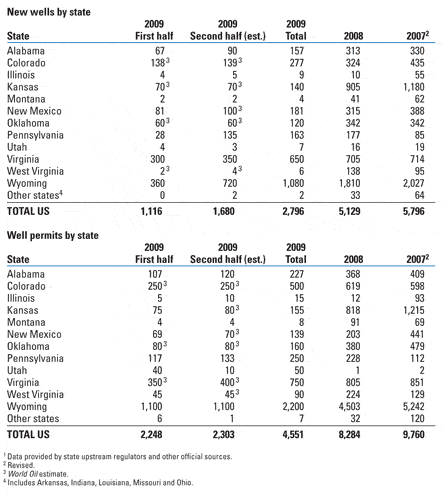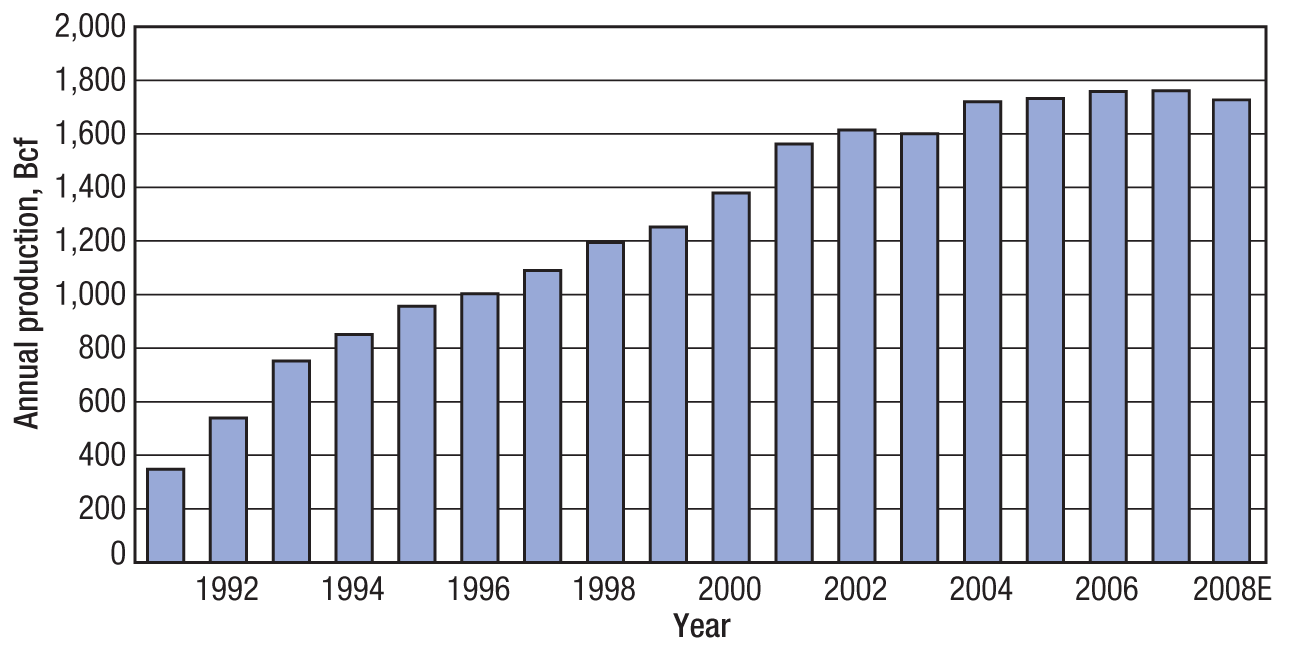As other regions ramp up their CBM activity, the North American sector faces tough times.
David Michael Cohen, Managing Editor
Low gas prices and the general economic slump have hit an already faltering North American coalbed methane sector especially hard, with CBM drilling in the US predicted to fall by almost half in 2009 compared with the previous year. Although Canadian CBM drilling continued its gentle decline last year, production from CBM wells in Alberta increased 8%, providing an increasing share of total natural gas production in 2008. Meanwhile, coalbed methane got big boosts outside North America, with new projects in China and Australia’s burgeoning CBM sectors continuing into 2009.
US CBM activity. Operators in the US drilled 5,129 wells for coalbed methane in 2008, according to data reported by regulatory officials in CBM-producing states, Table 1. This number is 667 (12%) fewer than in 2007, continuing a slowdown from a high of 7,357 wells in 2006. Permitting fell 15% from 2007 levels, with state agencies issuing 8,284 permits to drill CBM wells in 2008. This slowdown resulted from a number of factors including high dewatering costs for CBM wells, permitting delays and low Opal, Wyoming, gas prices, which dragged down activity in the most prolific state for CBM drilling.
| TABLE 1. US coalbed methane wells and permits |
 |
With the general collapse of natural gas prices starting in August 2008 and the worldwide recession, this downturn in US coalbed methane drilling has greatly accelerated; just 1,116 CBM wells are estimated to have been drilled in the first half of 2009, and World Oil predicts a 2009 total of 2,796 wells, a decrease of 45% from 2008. These numbers are qualified by the fact that multiple challenges continue to make collecting CBM statistics difficult, including long time lags in reporting and discrepancies in how states categorize wells targeting both coal seams and conventional gas deposits.
In contrast with the previous two years, the expected 2009 CBM drilling reduction doesn’t seem to be concentrated in one or two states, but instead is widely distributed among several CBM-producing states. Coalbed methane drilling is expected to fall by the biggest percentages in states that had relatively small numbers of wells in previous years as well: Montana (90%) and West Virginia (96%).
Kansas, the second most prolific CBM drilling state, also expects an especially large drilling reduction this year. After drilling 905 CBM wells last year, 275 less than the previous year but still more than any other state except Wyoming, data from the state’s oil and gas regulatory body suggests that Kansas will only drill 140 wells in 2009, a reduction of 85%. State regulators have long complained of high dewatering costs as operators run out of disposal capacity for produced water, and at current gas prices such costs are prohibitive.
A notable exception to the US trend is Virginia, which according to state regulators drilled 300 wells in the first half of 2009 and expects to drill 350 more in the second half, for a 2009 total that is only 8% less than the 705 wells the state drilled last year. According to David Asbury, director of the oil and gas division of the state Department of Mines, Minerals and Energy, the reason for Virginia’s relatively strong coalbed methane activity in 2009 is that most CBM production there is primarily done to de-gas coal seams to prepare them for mining, which has remained quite active in spite of the recession.
In line with the falling CBM drilling activity of the last few years, the Energy Information Administration (EIA) reports that CBM production in the US remained relatively flat in 2007 for its third straight year, with 1.754 Tcf of output, Fig. 1. That’s slightly down from the previous year, and World Oil estimates another slight decrease in US coalbed methane production for 2008, to 1.74 Tcf. Although most CBM-producing states actually increased output in 2007, their contributions were more than offset by a 23% drop in production from New Mexico. The San Juan Basin, which New Mexico shares with Colorado, produces 52% of total US coalbed methane.
 |
|
Fig. 1. US coalbed methane production.
|
|
Canadian CBM. Alberta remains Canada’s only substantial coalbed methane-producing province, though at the beginning of 2009 GeoMet Inc. announced that it had commenced gas deliveries from eight wells at the Peace River coalbed methane project located near Hudson’s Hope, British Columbia. Peace River is the first commercial coalbed methane project in that province.
In Alberta, 1,926 CBM wells were drilled in 2008, down 12% from 2,183 wells drilled the previous year, according to the provincial Energy Resources Conservation Board (ERCB). This continues a downward trend from a peak in 2006.
A much greater reduction was seen in the number of new well connections into CBM-producing zones, from 2,465 in 2007 down 41% to 1,466. Nonetheless, Alberta’s total production from CBM wells was up 8% at 283 Bcf (773 MMcfd) for 2008, from 261 Bcf (715 MMcfd) the previous year. ERCB includes commingled flow from wells that produce both from conventional gas reservoirs and from coal seams, although new reporting practices have decreased the number of these hybrid wells. The agency estimates that 77% of the 2008 cumulative output from wells drilled into coal seams was actually CBM, or 219 Bcf (598 MMcfd). CBM is becoming a more significant contributor to the Canadian natural gas mix, with gas from coalbed methane wells making up 6.4% of Alberta’s gas output in 2008, up from 5.8% the previous year.
ERCB expects operators in Alberta to connect 1,400 new wells for CBM production in 2009 and to continue connecting an average of 1,600 wells per year through 2018, by which time production from CBM wells is forecast to rise over 60% to 1.27 Bcfd.
Outside North America. As coalbed methane activity in the US and Canada declines, other countries are ramping up their investment in development of this resource, especially China and Australia.
The former country issued new targets in April 2009 to boost output of CBM as a safer and more environmentally friendly alternative to coal, following a string of deadly coal mining incidents in recent years and ongoing international pressure to reduce carbon dioxide emissions. In 2008, China exploited 63.7 Bcf (174 MMcfd) of the coalbed methane released from the country’s coal seams for power generation and fuel. The powerful National Development and Reform Commission (NDRC) wants to increase that number by establishing 18 CBM production hubs by early 2010, each producing 9.7 MMcfd. By 2015, the government intends to establish 36 such hubs producing a total of 348 MMcfd.
Beijing has introduced a series of incentives to encourage commercialization of the country’s vast CBM resources, including deregulated pricing, tax rebates on equipment, and a waiver on resource taxes. Since these incentives were announced, US-based Pacific Asia Petroleum announced plans to start drilling in the Zijinshan coalbed methane block in China’s Ordos Basin during the fourth quarter of this year, joining the handful of foreign firms already operating under production sharing contracts with Chinese state companies in the CBM sector. Other companies, such as Australia’s Arrow Energy, have negotiated feasibility studies on CBM extraction with local coal miners.
Also in July 2009, Shanxi Hong Kong & China Coalbed Gas Company began commercial operation of the first phase of a $98 million coalbed methane liquefaction plant in China’s northern Shanxi province. The plant has a liquefaction capacity of 8.8 Bcfd.
Eastern Australia’s market for coalbed methane (called coal seam gas or CSG) saw a rash of corporate activity in 2008, as international majors bought into the extensive reserves held by a number of smaller local producers, with a view to developing LNG projects. Malaysian state-owned Petronas agreed to pay $2.5 billion for a 40% stake in Australian E&P company Santos’ planned LNG project in the port city of Gladstone; Shell agreed to pay about $740 million for 30% of Arrow Energy’s Queensland CSG reserves; and ConocoPhillips agreed to pay up to $8 billion for a 50% stake in Origin Energy’s CSG reserves in the eastern state of Queensland, which are to be developed to feed the Gladstone LNG project. 
|




